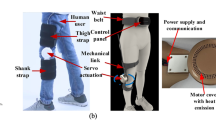Abstract
Knee exoskeleton plays an important role in robot-assisted rehabilitation for impaired pilots to restore their motor functionality of lower extremity through producing external movement compensation. Tracking control of knee exoskeleton often encounters time-dependent (time-varying) issues reflected in its dynamic behaviors. In many applications, inertial and viscous parameters of knee exoskeletons are measured to be time-dependent due to unexpected mechanical vibrations and contact interactions, which increases difficultly of accurate control of knee exoskeleton to follow desired joint angle trajectories. This paper proposes a novel control strategy for controlling knee exoskeleton with time-dependent (time-varying) inertial and viscous coefficients. Such controller is designed based on Zhang dynamics (ZD) method and utilizes twice Zhang function (ZF) so as to make the tracking error of joint angle exponentially converge to zero. Illustrative simulation examples and experimental validation are presented to show efficiency of this type of controller based on ZD method. Comparisons with gradient dynamic (GD) approach are also presented to demonstrate superiority of ZD-type control strategy for tracking joint angle of knee exoskeleton.
Similar content being viewed by others
References
A. B. Zoss, H. Kazerooni, and A. Chu, “Biomechanical design of the berkeley lower extremity exoskeleton (bleex),” IEEE/ASME Transactions on Mechatronics, vol. 11, no. 2, pp. 128–138, 2006. [click]
J. Ghan and H. Kazerooni, “System identification for the berkeley lower extremity exoskeleton (bleex),” Proceedings 2006 IEEE International Conference on Robotics and Automation (ICRA), IEEE, pp. 3477–3484, 2006. [click]
Y. Sankai, “Hal: Hybrid assistive limb based on cybernics,” Robotics Research, pp. 25–34, Springer, 2010. [click]
G. Aguirre-Ollinger, J. E. Colgate, M. A. Peshkin, and A. Goswami, “Design of an active one-degree-of-freedom lower-limb exoskeleton with inertia compensation,” The International Journal of Robotics Research, vol. 30, no. 4, pp. 486–499, 2011. [click]
W. Huo, S. Mohammed, Y. Amirat, and K. Kong, “Active impedance control of a lower limb exoskeleton to assist sitto- stand movement,” Proc. of IEEE International Conference on Robotics and Automation (ICRA), IEEE, pp. 3530–3536, 2016.
K. Knaepen, P. Beyl, S. Duerinck, F. Hagman, D. Lefeber, and R. Meeusen, “Human–robot interaction: Kinematics and muscle activity inside a powered compliant knee exoskeleton,” IEEE Transactions on Neural Systems and Rehabilitation Engineering, vol. 22, no. 6, pp. 1128–1137, 2014.
G. Aguirre-Ollinger, J. E. Colgate, M. A. Peshkin, and A. Goswami, “Active-impedance control of a lower-limb assistive exoskeleton,” Proc. of IEEE 10th International Conference on Rehabilitation Robotics, IEEE, 2007.
M. Laffranchi, N. G. Tsagarakis, and D. G. Caldwell, “A variable physical damping actuator (vpda) for compliant robotic joints,” Proc. of IEEE International Conference on Robotics and Automation (ICRA), IEEE, pp. 1668–1674, 2010. [click]
D. Zanotto, Y. Akiyama, P. Stegall, and S. K. Agrawal, “Knee joint misalignment in exoskeletons for the lower extremities: Effects on user’s gait,” IEEE Transactions on Robotics, vol. 31, no. 4, pp. 978–987, 2015. [click]
Y. Zhang and C. Yi, Zhang Neural Networks and Neuraldynamic Method, Nova Science Publishers, Inc., 2011.
Y. Zhang, Z. Xiao, D. Guo, M. Mao, and Y. Yin, “Singularity-conquering tracking control of a class of chaotic systems using zhang-gradient dynamics,” IET Control Theory & Applications, vol. 9, no. 6, pp. 871–881, 2015. [click]
B. Liao and Y. Zhang, “Different complex zfs leading to different complex znn models for time-varying complex generalized inverse matrices,” IEEE Transactions on Neural Networks and Learning Systems, vol. 25, no. 9, pp. 1621–1631, 2014. [click]
D. Guo and Y. Zhang, “Li-function activated znn with finite-time convergence applied to redundant-manipulator kinematic control via time-varying jacobian matrix pseudoinversion,” Applied Soft Computing, vol. 24, pp. 158–168, 2014. [click]
K. Kong and M. Tomizuka, “Smooth and continuous human gait phase detection based on foot pressure patterns,” Proc. of IEEE International Conference on Robotics and Automation (ICRA), pp. 3678–3683, May 2008.
R. Huang, H. Cheng, H. Guo, Q. Chen, and X. Lin, “Hierarchical interactive learning for a human-powered augmentation lower exoskeleton,” Proc. of IEEE International Conference on Robotics and Automation (ICRA), IEEE, pp. 257–263, 2016.
D. M. Ka, H. Cheng, T. Huu Toan, and J. Qiu, “Minimizing human-exoskeleton interaction force by using global fast sliding mode control,” International Journal of Control, Automation and Systems, no. 4, pp. 1064–1073, 2016. [click]
Author information
Authors and Affiliations
Corresponding author
Additional information
Recommended by Associate Editor Kyoungchul Kong under the direction of Editor Hyun-Seok Yang. This work was supported by the National Natural Science Foundation of China (NSFC) under grant No. 61603078 and Fundamental Research Funds for the Central Universities at University of Electronic Science and Technology of China (UESTC) under grant No. ZYGX2015KYQD044.
Zhan Li received his Ph.D. degree from University of Montpellier, France in 2014. From 2011 to 2014, He was working in INRIA, Montpellier, France. He is currently with School of Automation Engineering, University of Electronic Science and Technology of China (UESTC), Chengdu, China. His research interests include rehabilitation robotics, functional electrical stimulation, and neural networks.
Ziguang Yin is an experienced mechanical engineering with School of Automation Engineering, University of Electronic Science and Technology of China (UESTC) and Buffalo Robot Corporation, Chengdu, China. His research interests include mechanics design and prototyping.
Rights and permissions
About this article
Cite this article
Li, Z., Yin, Z. Zhang Dynamics based Tracking Control of Knee Exoskeleton with Timedependent Inertial and Viscous Parameters. Int. J. Control Autom. Syst. 16, 904–911 (2018). https://doi.org/10.1007/s12555-017-0011-8
Received:
Revised:
Accepted:
Published:
Issue Date:
DOI: https://doi.org/10.1007/s12555-017-0011-8




